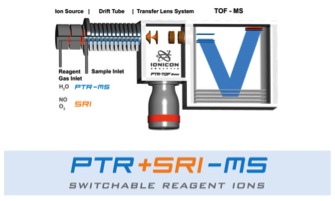Posting a note from my [gleeful] chemistry colleagues Allen Goldstein and Pawel Misztal about the new instrument that is headed our way.
BIMERC will soon receive an exceptionally unique and powerful Proton Transfer Reaction Time-of-Flight Mass Spectrometer (PTR-ToF-MS 8000) for instantaneous detection of a full range gas-phase organics including microbial volatile organic compounds (MVOC). There are currently only a few such instruments in the US. While previous studies on MVOC measurements typically reported dozens of compounds in a single study, this new instrument can typically see many hundreds of compounds in the ambient atmosphere. For example, according to a recent study led by Goldstein, 664 organic compounds were observable above an orange grove, and the vast majority were actively being taken up or emitted by the ecosystem.
We expect that many hundreds of compounds will be routinely observable in microbial emissions and indoor environments, and we will be investigating the microbial emission chemical signatures that are present. The instruments’ unique advantages include fast time resolution (a fraction of a second), high mass resolution (~0.001 atomic mass units) and low detection limits (typically a few parts per trillion), enabling measurements of chemical composition in real time for an extensive range of compounds, and how this composition varies in response to changes in temperature, humidity, presence of humans, etc. Furthermore, the new instrument is equipped with the switchable reagent ion feature (SRI) which further expands the detectable range of compounds and in many cases can help elucidate their structure using ion chemistries of H3O+, NO+, and O2+.
We look forward to using this new instrument in our planned BIMERC and Indoor Air Chemistry Sloan funded research, and also utilizing it to develop new collaborative investigations with other SLOAN researchers on a wide range of questions related to sources, chemistry, and fate of VOCs in the indoor environment.
